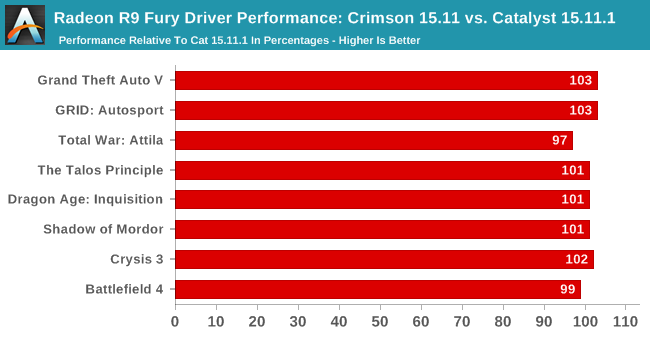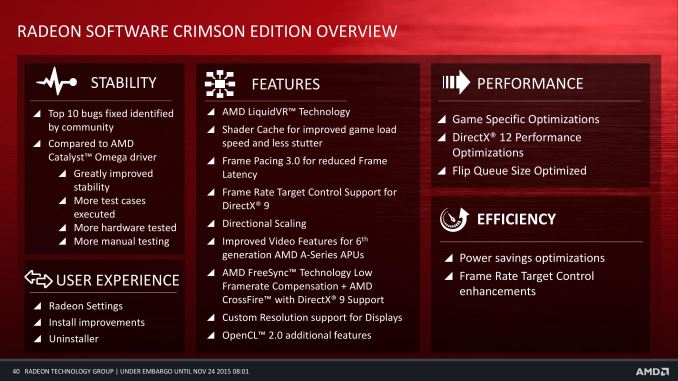AMD's Radeon Software Crimson Driver Released: New Features & A New Look
by Ryan Smith & Daniel Williams on November 24, 2015 8:00 AM ESTCrimson Performance
Last but certainly not least, let’s talk about performance improvements. Like the Omega driver before it, Crimson comes with a collection of performance improvements from AMD’s new driver branch. To preface this with caution, I don’t think anyone should be expecting massive system-wide performance gains – that’s all low-hanging fruit AMD picked long ago – but there’s plenty of room for some lesser optimizations along with game-specific optimizations.
AMD’s own numbers point to game-specific improvements of up to 20%, though it should be noted that AMD’s best-case numbers are on unreleased/beta games that have yet to be well-optimized in the first place. Otherwise AMD’s own numbers are far more tame, listing recently released games with gains between three and five percent.
To take a quick look at general performance, we went ahead and ran our GPU benchmark suite at 2560x1440 on our Radeon R9 Fury (vanilla), comparing the previous Catalyst 15.11.1 beta to the new Radeon Software Crimson 15.11 beta. The Fury and its underlying Fiji GPU is the newest product out of AMD, so it offers AMD the best opportunity to unlock any remaining performance in the architecture.

Overall the average performance gain at 2560x1440 is just 1%. There are a couple of instances where there are small-but-consistent performance gains – Grand Theft Auto V and Grid: Autosport stand out here – but otherwise the performance in our other games is within the margin of error, plus or minus. Not that we were expecting anything different as this never was pitched as a golden driver, but this does make it clear that more significant performance gains are going be on a per-game basis.
Final Thoughts
Wrapping things up, AMD’s development structure in the past year and going forward is one that has both been beneficial to the company and has brought with it its own drawbacks. By focusing feature releases around the end of the year driver, AMD is able to cut down on what parts of the driver they change (and thereby can possibly break) at other times of the year, and try to knock out all of their feature-related bugs at once. At the same time it makes the annual driver release a significant event, as AMD releases a number of new features all at once. However on the other hand this means that AMD has few features launching any other time of the year, which can make it look like they’re not heavily invested in feature development at those points. Then of course there’s the WHQL element, where for multiple reasons AMD hasn’t issued very many WHQL releases this year, and is something they’re seeking to change in 2016.
Looking under the hood there’s no single feature that’s going to blow every Radeon user away at once, but overall there are a number of neat features here that should be welcomed by various user groups. The Freesync Low Framerate Compensation changes should be of particular interest to Freesync users, while shader caching will improve shader loading performance across the board. Otherwise smaller fixes like the DirectX 9 improvements to CrossFire frame pacing, CrossFire Freesync, and framerate target control should be welcome news to APU and dual graphics users.
Meanwhile AMD’s radical overhaul of their control panel via the new Radeon Settings application will be quickly noticed by everyone. Though there’s plenty of room for interpretation on style and just how a good control panel is laid out, AMD has clearly put a lot of effort into cleaning up the layout of their control panel and it shows, as important options are no longer buried under multiple layers of menu trees. And on the performance front Radeon Settings is faster than Catalyst Control Center even on fast machines, and though we haven’t spent much time on covering it, AMD has also managed to speed up the installation process while they were at it. So all-told the Crimson release has something for everyone.
Ultimately I hesitate to ascribe too much of this to the Radeon Technologies Group too soon – this project has clearly been in the works longer than 3 months – but at the same time this is the RTG making their mark. It’s a new direction for AMD’s graphics group and a new look to match. And if the RTG can meet their stability, performance, and release goals going forward with the new Crimson driver, then they should be able to make 2016 a good year for the Radeon user base.


















146 Comments
View All Comments
looncraz - Wednesday, November 25, 2015 - link
I've used AMD on Linux (and HaikuOS) for years. No problems.Not good for gaming, but who the heck games on desktop Linux, anyway?
Nobody, that's who.
Beany2013 - Wednesday, November 25, 2015 - link
I'm a nobody :-(Metro Last Light works fine on Ubuntu. You know, once you work around the horrific issues with GCC compatability...
tamalero - Thursday, December 3, 2015 - link
hipsters and their linux.I actually wonder how many games are released for Linux.
hyno111 - Tuesday, November 24, 2015 - link
Although my only GCN card is broken, I'm glad AMD finally dropped pre-GCN support to better support current cards. Hope to see the next graphic architecture in near future..ishJJx3 - Tuesday, November 24, 2015 - link
Not sure where you heard that from, but the 5000 and 6000 series are still fully supported in this update. And although DX12 will not be supported on pre-GCN cards, it would still not be a good idea for them to drop support on them.jasonelmore - Tuesday, November 24, 2015 - link
how many WHQL drivers do the competition release? 6 seems like a low number.I know Nvidia has had 3 in November alone, and at least 10 since may
yannigr2 - Tuesday, November 24, 2015 - link
Yes and Nvidia's WHQL drivers come with nice features like browsers crushing and cards running at 3D speeds when sitting idle in the desktop because the user happens to have a 144hz monitor.WHQL stump is NOT the Holly Grail of stability.
colinstu - Tuesday, November 24, 2015 - link
crushing? it's 'crashing' ...yannigr2 - Tuesday, November 24, 2015 - link
You are right...Chaser - Tuesday, November 24, 2015 - link
I never get that. Have owned Nvidia GPUs now going on 7 years.